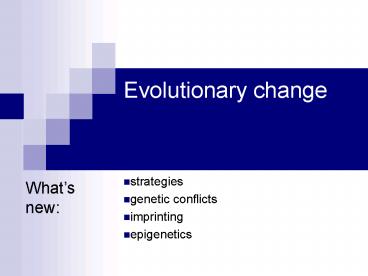Evolutionary change PowerPoint PPT Presentation
1 / 24
Title: Evolutionary change
1
Evolutionary change
- strategies
- genetic conflicts
- imprinting
- epigenetics
Whats new
2
evolution
Genetic variation
Selection
environment
development
Phenotypic variation
environment
Fitness variation
3
Evolution
To study the evolution of a sharks body it is
sufficient to look at the environment (prey,
properties of sea water etc.)
To study the evolution of mating behaviour we
have to consider the set of strategies played by
all members of the population.
4
Evolution
Evolutionary Stable Strategy a strategy that
cannot be beaten by any mutant playing a
different strategy
Analogy Nash Equilibrium in economics (beautiful
mind)
PC Hooft Tractor
5
Strategies S/R ratio
What will happen if we take away the division?
6
Strategies S/R ratio
- Prediction when plants compete for nutrients
they should increase their root to shoot ratio
even if the total amount of nutrients available
per plant is the same as in a situation without
competition.
- Result without the separation total seed
production is 30 lower
7
Strategies Sex ratios
- In humans we have a simple XX XY sex
determination system
Genotype Phenotype XX x XY f x m XX XY XX
XY f m f m
8
Strategies sex ratios
- In humans sex ratio seems fixed
- In many animals and plants the sex ratio can be
highly variable in stinging nettles it varies
among mothers from producing almost only sons to
almost only daughters
9
Strategies sex ratios
- A line of descendents that produces only females
multiplies at a faster rate than a line with both
males and females
f f x m f f f x m f f f f f x m
- Questions why are so many males produced?
10
Strategies sex ratios
Answer if all mothers produce daughters a mother
that produces sons would have a strong advantage
because her sons fertilize all the females in the
population and thus passes on much more genes to
the next generation In a well mixed population
with random mating the evolutionary stable sex
ratio is 50 sons
11
Genetic conflict
- Cytoplasmatic genes are only passed on through
the mother plant and have a selective advantage
if only females are produced - A genetic element in the cytoplasm that shifts
the sex ratio towards more daughters will sweep
through the population - If its frequency has increased and there are a
lot of females in the population there is a
selective advantage for a nuclear gene to restore
the effect of the cytoplasmatic gene.
12
Genetic conflict
Cytoplasm
- Evolutionary theory predicts a complicated system
of nuclear and cytoplasmatic genes with opposing
effects - the sex determination system will depend on the
history of the population and will differ among
populations of the same species - example Plantago lanceolata, drosophila
Feminising elements
restorer genes
nucleus
13
Genetic conflict Seed size
- The optimal investment of a mother in each of her
offspring is a compromise between quality and
offspring number - An individual offspring mostly benefits from a
very large investment
14
Genetic conflict seed size
- Prediction among the genes of the mother there
is a conflict between genes that give the mother
control over offspring size and genes transmitted
to the offspring that give the offspring control
over their size
15
Genetic conflict seed size
- However, if you take more resources yourself,
this is at the expense of the other offspring to
whom you are genetically related - The latter reduces the rate at which your genes
are transmitted to the next generation. It
reduces your inclusive fitness. - The degree of relatedness with the other
offspring matters.
16
Genetic conflict seed size
Seed mass Selfing species 0.036 partly selfing
species 0,590 outcrossing species 0,620
17
Genomic imprinting
- Generally, genes transmitted through the father
are less related than genes transmitted through
the mother because multiple fathers may have
sired the offspring of a single mother - Prediction a gene in the embryo that leads to
excess resources should be on when it comes
from the father and off when it comes from the
mother.
18
Genomic imprinting
- Genes are differently expressed when they come
from the mother or the father
19
Genomic imprinting
Crossing between tetraploid and diploid
Arabidopsis thaliana
20
Epigenetics
The study of heritable changes in gene function
that occur without a change in the sequence of
nuclear DNA. This includes the study of how
environmental factors affecting a parent can
result in changes in the way genes are expressed
in the offspring
21
Epigenetics
22
Epigenetics
23
Epigenetics
Changes to the structure of the chromatin have a
profound influence on gene expression if the
chromatin is condensed, the factors involved in
gene expression cannot get to the DNA, and the
genes will be switched off. Conversely, if the
chromatin is open, the genes can be switched on
if required. DNA methylation is a chemical
modification of the DNA molecule itself it is
carried out by an enzyme called DNA
methyltransferase. Methylation can directly
switch off gene expression by preventing
transcription factors binding to promoters.
24
Epigenetics

